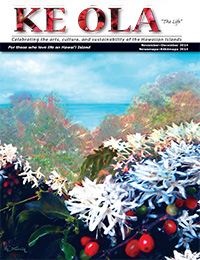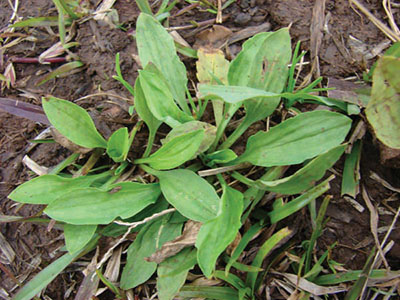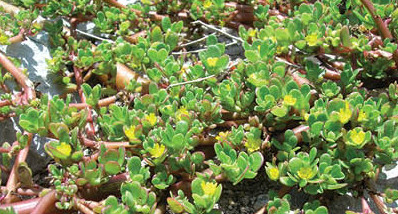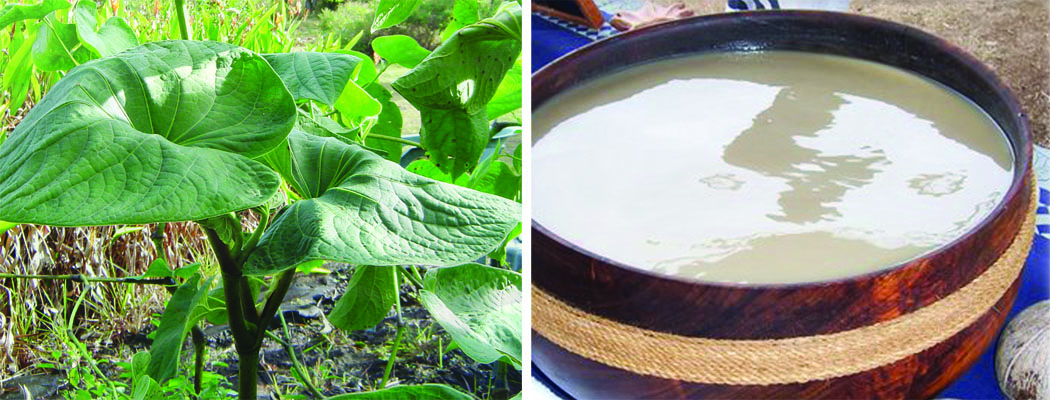
Healing Plants: Lau Kahi, an All-Around Helpful “Weed”

By Barbara Fahs
If you have a lawn, a pasture, or garden beds, you have probably mowed, weed whacked, or pulled out lau kahi. Commonly called plantain, this small broadleaf herb has no relationship to the plantains we know as cooking bananas. Instead, it’s a member of the genus Plantago, and some species or another exists on every continent on earth except the Arctic regions.
Early European voyagers introduced some species of plantain to Polynesia, and it formerly existed on many Polynesian islands. Today, however, it is common only here in the Hawaiian Islands. An endangered native species called kuahiwi laukahi (Plantago hawaiensis) still exists in rare places on Hawai‘i Island.
Common Species
Hawaiians who resided here when this plant was introduced recognized its medicinal effectiveness and named it lau kahi, translated as “leaf one,” or “one leaf,” referring to the parallel veins on the leaves, which make it look much like a grass.
More than 200 species of plantain exist around the world. The two most common types in Hawai‘i are Plantago lanceolata and Plantago major. All species are small, low-growing plants with thin or broad leaves in a rosette around the base, depending on the species. Lanceolata sports 6-inch, narrow, strap-like leaves. Major has 4-inch leaves that are wider and fleshier—it’s often called “broadleaf plantain.” They both produce a seedpod that is borne atop a tall stem, up to 12 inches high. All species that grow in Hawai‘i are known as lau kahi.
Edible Uses

Young, tender leaves of lau kahi are tasty in salads or cooked and eaten instead of spinach or kale. Always remember to wash all greens thoroughly before you eat them raw to ensure that no snails, slugs, or other insects are present.
Lau kahi is a good source of beta carotene (vitamin A) and calcium. It also contains ascorbic acid (vitamin C) and vitamin K.
The seeds of lau kahi are also edible. If you have a large number of these plants, harvest the seedpods, dry them, and then release them from the pods by knocking them onto a piece of paper. Quickly stir-fry them in a dry cast iron skillet over medium-high heat until they’re brown and crunchy and then add them to baked goods or grind them into flour, for a gluten-free alternative to wheat flour.
Medicinal Uses

In former times in Polynesia, lau kahi was used medicinally only in Hawai‘i and Tonga, where it is called filo.
Hawaiians of the past used lau kahi as a tonic for weakness, as a laxative and, externally, for boils, wounds, lacerations, and other skin maladies. They soaked the seeds and ate them to relieve constipation and intestinal inflammation.
In his book, The Way of Herbs, Michael Tierra reports that when taken as a tea or tincture or in any other oral form, plantain is useful for urinary tract infections, hepatitis, and bacterial dysentery. Christopher Hobbs’ book, Herbal Remedies for Dummies, adds that it is also effective for treating coughs, ulcers, colitis, and painful urination. The Physician’s Desk Reference for Herbal Medicines states, “No health hazards or side effects are known in conjunction with the proper dosage” of plantain. However, as with all medicines, consult your doctor before you attempt to treat yourself.
Lau Kahi Poultice for Skin Healing
- Gather 10-12 large lau kahi leaves and some flower spikes, if available. You may combine lau kahi with comfrey leaves.
- Chop up the plant material into 1-inch lengths.
- Boil 1 quart of filtered water in a non-metallic pan, such as Pyrex.
- Add your lau kahi and reduce the heat to a simmer.
- Simmer for 20 minutes, then remove from heat; cool.
- Scoop out the mushy plant material, squeeze the excess water from it and hold it on your wound for as long as you can. Use tape to hold the lau kahi in place for longer periods of time.
Photos courtesy Forest and Kim Starr
Contact writer Barbara Fahs: hiiakas@lava.net
Sources and more info
Ecos.fws.gov/speciesProfile/profile/speciesProfile.action?spcode=Q37S
Kalehua.net/healingHerbs.html
PrairieLandHerbs.com/plantain.htm
Acreage.unl.edu/Plantain
Polynesian Herbal Medicine. Dr. W. Arthur Whistler, National Tropical Botanical Garden, 1992.


